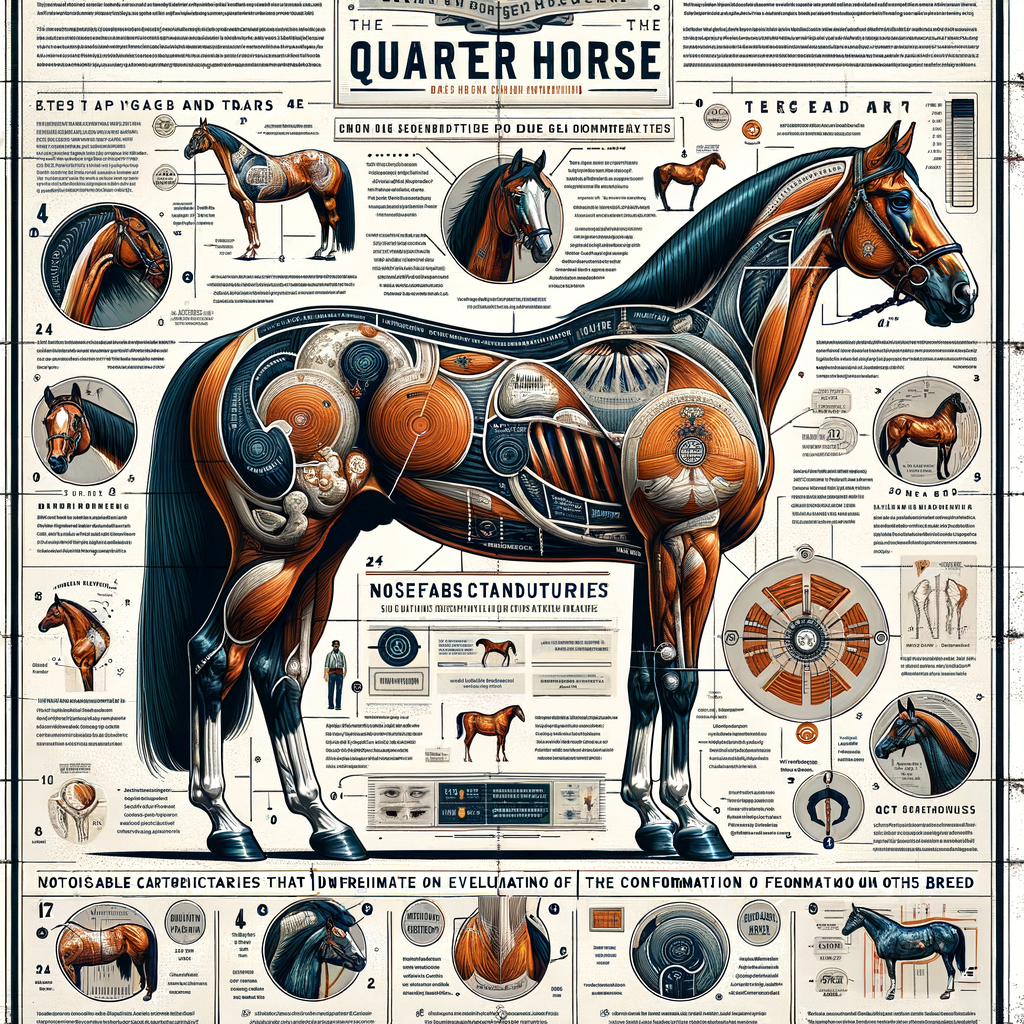
Introduction to Quarter Horse Breed
The Quarter Horse, known for its speed, agility, and versatility, is one of the most popular horse breeds in the world. This breed’s unique characteristics and rich history make it a favorite among horse enthusiasts and professionals alike. In this section, we will delve into the history and origin of the Quarter Horse breed and explore its significance and popularity.
-
- History and Origin of the Quarter Horse Breed
The Quarter Horse breed has a rich history that dates back to the 1600s. The breed originated in America, a result of crossbreeding between native horses of Spanish origin and English horses. The breed was named ‘Quarter Horse’ due to its exceptional speed in quarter-mile races. Over the centuries, the Quarter Horse has evolved, but it has always retained its reputation for speed and agility.
-
- Significance and Popularity of the Quarter Horse Breed
The Quarter Horse breed holds a significant place in the equestrian world. Its versatility makes it suitable for a variety of equestrian activities, including racing, rodeo events, and working as a ranch horse. The breed’s calm demeanor and intelligence also make it a popular choice for therapeutic riding programs.
According to the American Quarter Horse Association, there are over 3 million registered Quarter Horses worldwide, making it one of the most popular horse breeds. Its popularity is not confined to the United States; the breed has a significant presence in countries like Canada, Germany, and Australia.
In the following sections, we will delve deeper into the characteristics, anatomy, and breeding standards of the Quarter Horse breed. We will also look at some successful Quarter Horses and what to look for in Quarter Horse conformation. Stay tuned to learn more about this fascinating breed.
Understanding Horse Conformation
When it comes to horses, especially the Quarter Horse breed, conformation plays a crucial role. But what exactly is horse conformation, and why is it so important? Let’s delve into this topic and shed some light on these questions.
-
- Definition and Importance of Horse Conformation
Horse conformation refers to the physical appearance and body structure of a horse, which is largely determined by its genetics. It includes aspects such as the horse’s bone structure, muscle development, and the shape and function of its body parts. The conformation of a horse can greatly affect its ability to perform certain tasks.
For instance, a horse with a well-built, muscular body might be more suitable for heavy-duty tasks like pulling carts or plowing fields. On the other hand, a horse with a lean and agile body might be better suited for racing or jumping. Therefore, understanding horse conformation is vital for anyone involved in breeding, training, or riding horses.
-
- Key Considerations in Horse Conformation
When evaluating a horse’s conformation, there are several key factors to consider. These include the horse’s overall balance and symmetry, the strength and straightness of its legs, the shape and size of its hooves, and the depth and width of its chest. Other important factors include the horse’s neck and head shape, its shoulder and hip angles, and the length and slope of its back.
It’s also important to note that different breeds of horses have different conformation standards. For example, the Quarter Horse breed is known for its muscular body, broad chest, and powerful hindquarters, which make it well-suited for quick sprints and sharp turns.
In conclusion, understanding horse conformation is not just about appreciating a horse’s physical beauty. It’s about recognizing the strengths and weaknesses of a horse, and how these can impact its performance and health. Whether you’re a horse breeder, trainer, or simply a horse lover, gaining a deeper understanding of horse conformation can greatly enhance your knowledge and appreciation of these magnificent creatures.
Characteristics of Quarter Horse
The Quarter Horse is a versatile breed with unique characteristics that set it apart from other horse breeds. These characteristics can be divided into two main categories: physical traits and behavioral traits. Let’s take a closer look at each of these categories.
- Distinct Physical Traits of Quarter Horse
The Quarter Horse is known for its muscular build, particularly in the hindquarters. This breed typically stands between 14.3 and 16 hands high, with males weighing between 1,000 and 1,200 pounds and females weighing between 950 and 1,150 pounds. They have a broad chest and powerful, well-muscled legs, particularly in the hindquarters, which contribute to their exceptional speed and agility.
Their heads are finely chiseled with a straight profile, wide forehead, and alert, intelligent eyes. The neck is muscular but not overly long, blending smoothly into well-sloped shoulders. The back is short and strong, leading to a rounded, muscular hindquarters. The tail is typically long and flowing.
Quarter Horses come in a variety of colors, with the most common being sorrel (a rich chestnut color). Other colors include bay, black, brown, buckskin, dun, red dun, gray, grullo, palomino, red roan, blue roan, and white.
- Behavioral Characteristics of Quarter Horse
Quarter Horses are known for their calm and docile temperament. They are intelligent, eager to please, and adaptable, making them suitable for a variety of equestrian activities. They are often described as ‘people-oriented’, forming strong bonds with their human handlers.
Despite their powerful build and speed, Quarter Horses are typically easy to handle and train. They have a natural willingness to learn and a strong work ethic. They excel in a variety of disciplines, including racing, rodeo events, show jumping, dressage, and trail riding.
Quarter Horses are also known for their ‘cow sense’, an instinctive understanding of how to work with cattle. This makes them particularly valuable for ranch work and rodeo events such as cutting and team penning.
In summary, the Quarter Horse’s distinct physical and behavioral characteristics make it a versatile and popular breed, suitable for a wide range of equestrian activities.
Evaluating Quarter Horse Conformation
When assessing the conformation of a Quarter Horse, it’s essential to look at their body structure. This involves examining the head and neck, body and back, and legs and feet.
Quarter Horse Body Structure
The body structure of a Quarter Horse is a key factor in determining its performance and health. Let’s delve into the specifics:
-
- Head and Neck
The head of a Quarter Horse should be well-proportioned to its body. It should have a straight profile, wide forehead, and large, expressive eyes. The neck should be of medium length, strong, and flexible, allowing for easy movement and control.
-
- Body and Back
The body of a Quarter Horse should be muscular yet compact. The back should be short and strong, with a broad, flat loin. The chest should be deep and wide, providing ample space for the heart and lungs.
-
- Legs and Feet
The legs of a Quarter Horse should be sturdy and well-muscled, with short cannon bones and long, sloping pasterns for shock absorption. The feet should be round and tough, indicative of good health and durability.
Understanding the body structure of a Quarter Horse is vital in evaluating its conformation. A well-structured horse will not only perform better but also have fewer health issues. Remember, a horse’s conformation is a reflection of its potential ability and longevity.
Quarter Horse Physical Traits
When evaluating the conformation of a Quarter Horse, two important physical traits to consider are the coat and color, and the size and weight of the horse. These traits not only contribute to the horse’s appearance but also give us insights into the horse’s health and performance capabilities.
-
- Coat and Color
The Quarter Horse breed exhibits a wide range of coat colors. The most common colors include bay, black, brown, chestnut, dun, gray, grullo, palomino, red dun, sorrel, and white. The coat of a Quarter Horse is typically short, thick, and glossy, indicating good health and proper nutrition. The color and condition of a horse’s coat can change with the seasons, diet, and health status.
-
- Size and Weight
Quarter Horses are known for their compact size and muscular build. The average height of a Quarter Horse ranges from 14 to 16 hands (56 to 64 inches) tall at the shoulder. As for weight, most Quarter Horses weigh between 950 to 1,200 pounds. However, the size and weight can vary depending on the horse’s diet, exercise routine, and genetic factors.
Understanding these physical traits is crucial when evaluating a Quarter Horse’s conformation. A horse with a healthy coat and an appropriate size and weight for its breed is likely to perform well and have fewer health issues.
| Physical Trait | Description |
|---|---|
| Coat and Color | Varies, most commonly bay, black, brown, chestnut, dun, gray, grullo, palomino, red dun, sorrel, and white. Short, thick, and glossy coat indicates good health. |
| Size and Weight | Average height ranges from 14 to 16 hands (56 to 64 inches) tall at the shoulder. Weight typically between 950 to 1,200 pounds. |
Quarter Horse Breeding and Standards
When it comes to breeding Quarter Horses, there are certain practices and standards that are followed to ensure the health and quality of the breed. Let’s delve into these in more detail.
-
- Quarter Horse Breeding Practices
Quarter Horse breeding practices are designed to produce horses that excel in speed, agility, and versatility. These practices often involve selecting parent horses that have proven themselves in competitions and have desirable physical and temperamental traits.
One common practice is line breeding, where horses with similar lineage are bred to reinforce certain traits. However, care is taken to avoid inbreeding, which can lead to health problems. Another practice is outcrossing, where horses from different bloodlines are bred to introduce new traits and increase genetic diversity.
Proper care of the mare and stallion is also crucial in Quarter Horse breeding. This includes providing a balanced diet, regular exercise, and veterinary care. The mare’s pregnancy is closely monitored to ensure the health of both the mare and the foal.
-
- Standards and Expectations in Quarter Horse Breeding
The American Quarter Horse Association (AQHA) sets the standards for Quarter Horse breeding. These standards focus on the horse’s conformation, or physical appearance, and its ability to perform in various events.
The ideal Quarter Horse has a small, refined head, a broad chest, and a muscular, compact body. It should also have strong, sturdy legs and a well-defined, sloping shoulder. In terms of temperament, the Quarter Horse should be calm, intelligent, and willing to work.
These standards are not just for breeders, but also for potential buyers. When looking at a Quarter Horse, it’s important to evaluate its conformation and temperament to ensure it meets these standards. Remember, a horse that meets these standards is more likely to perform well and be a pleasure to own.
In conclusion, Quarter Horse breeding is a careful process that involves selecting the right parent horses, providing proper care, and adhering to the standards set by the AQHA. By understanding these practices and standards, you can make informed decisions when breeding or buying a Quarter Horse.
Anatomy of Quarter Horse
The Quarter Horse, known for its speed and agility, has a unique anatomy that contributes to its exceptional performance. To truly appreciate this breed, it is important to understand its skeletal and muscular systems. This knowledge can also be useful when evaluating a Quarter Horse’s conformation and potential for success in various equestrian disciplines.
-
Understanding the Quarter Horse’s Skeletal Structure
The Quarter Horse’s skeletal system is designed for power and speed. It consists of approximately 205 bones, each playing a crucial role in the horse’s movement and overall health. The most noticeable feature of the Quarter Horse’s skeletal structure is its broad, powerful hindquarters, which provide the propulsion necessary for quick bursts of speed.
Another key characteristic of the Quarter Horse’s skeletal structure is its compact and well-balanced body. The horse’s back is typically short with strong loins, allowing for quick, agile movements. The legs are sturdy and well-muscled, with short cannon bones contributing to the horse’s strength and durability.
Understanding the skeletal structure of a Quarter Horse can help owners and breeders make informed decisions about training, care, and breeding. It’s also essential for evaluating a horse’s conformation and potential for success in various equestrian disciplines.
-
Muscular System of the Quarter Horse
The Quarter Horse’s muscular system is equally impressive, and it’s what gives this breed its distinctive power and agility. The most prominent muscles are found in the hindquarters, specifically the gluteal and hamstring muscles. These muscles provide the explosive power necessary for the Quarter Horse’s renowned sprinting ability.
The Quarter Horse also has a well-developed chest and shoulder muscles, contributing to its strength and endurance. These muscles allow the horse to maintain balance and stability, even when performing quick, agile movements.
Understanding the muscular system of a Quarter Horse is not only fascinating but also practical. It can help owners and trainers develop effective training programs that enhance the horse’s natural abilities and prevent injury.
In conclusion, the Quarter Horse’s unique anatomy, including its skeletal and muscular systems, contributes to its reputation as a powerful, agile breed. Understanding these systems can help owners, breeders, and trainers make informed decisions about care, training, and breeding.
Case Studies: Successful Quarter Horses
Let’s take a closer look at some examples of successful Quarter Horses. These case studies will help us understand the potential of this breed and what makes them stand out in their respective fields.
-
Case Study 1: Famous Racing Quarter Horses
One of the most famous Quarter Horses in the racing world is Special Effort. Born in 1979, Special Effort is the only horse in the history of the American Quarter Horse Association (AQHA) to have won the Triple Crown. This achievement means that he won all three of the nation’s top Quarter Horse racing events in a single season.
Special Effort’s success can be attributed to his exceptional conformation, which includes a well-balanced body, strong hindquarters, and a compact build. His speed and agility, typical of the Quarter Horse breed, made him a formidable competitor on the racetrack.
-
Case Study 2: Successful Show Quarter Horses
In the show ring, one Quarter Horse that has made a significant impact is Zippo Pine Bar. This horse, born in 1969, is known for his remarkable performance in Western Pleasure competitions. Zippo Pine Bar won numerous championships and was inducted into the AQHA Hall of Fame in 2000.
Zippo Pine Bar’s success in the show ring can be attributed to his excellent conformation, calm demeanor, and smooth movements. His ability to perform intricate maneuvers with grace and precision is a testament to the versatility of the Quarter Horse breed.
These case studies highlight the versatility and potential of Quarter Horses. Whether on the racetrack or in the show ring, these horses have demonstrated the characteristics that make the Quarter Horse breed so special. Their success serves as an inspiration for horse enthusiasts and breeders alike.
Key Takeaways: What to Look For in Quarter Horse Conformation
Understanding the conformation of a Quarter Horse is crucial for various reasons, including breeding, performance, and overall health. Here are some key points to remember and common mistakes to avoid when evaluating Quarter Horse conformation.
-
- Important Points to Remember When Evaluating Quarter Horse Conformation
When assessing a Quarter Horse’s conformation, it’s essential to look at the horse as a whole. Here are some key points to consider:
-
-
- Balance: The horse’s body should be proportionate. The neck, body, and hindquarters should each take up about one-third of the horse’s length.
- Musculature: Quarter Horses are known for their muscular build, particularly in the hindquarters. This muscle mass is key to their speed and agility.
- Bone Structure: The horse’s bones should be strong and well-formed, with straight legs and well-aligned joints.
- Feet: The horse’s feet should be of good size, well-shaped, and hard. The hooves should be proportionate to the horse’s size.
- Common Mistakes to Avoid
-
While evaluating a Quarter Horse’s conformation, it’s easy to make some common mistakes. Here are a few to avoid:
-
- Ignoring Balance: It’s easy to focus on individual parts of the horse, like the muscular hindquarters, and overlook overall balance. Always consider the horse as a whole.
- Overlooking Bone Structure: While musculature is important, don’t forget to assess the horse’s bone structure. Poor bone structure can lead to health and performance issues.
- Not Considering the Horse’s Purpose: A horse’s conformation should suit its intended use. For example, a racing Quarter Horse may have a different ideal conformation than a working Quarter Horse.
In conclusion, understanding Quarter Horse conformation can seem complex, but with careful observation and consideration of the key points mentioned above, you can make informed evaluations. Remember, the goal is to find a horse that is well-balanced, strong, and suited to its intended purpose.









